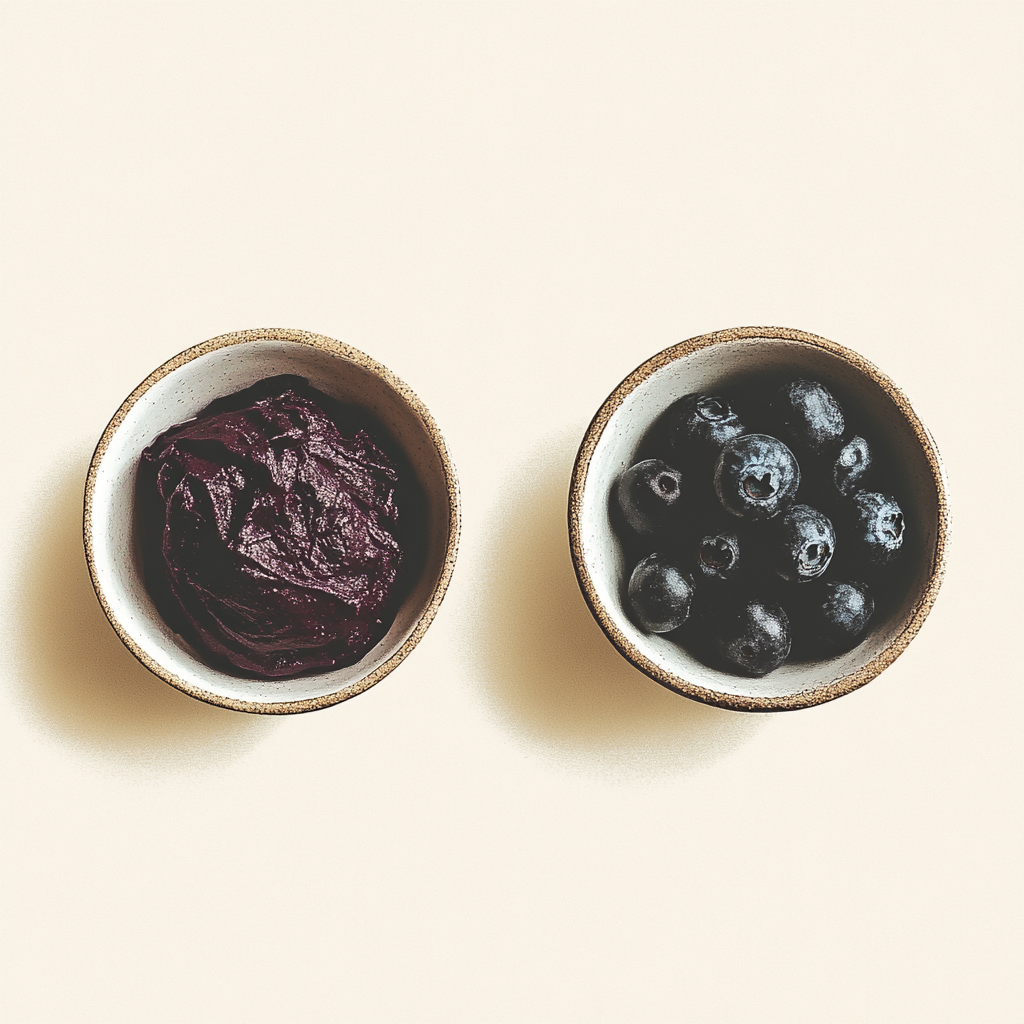
Purple delights: are açaí and blueberries the same?
You’ve probably noticed them side-by-side, or at least, heard them mentioned in the same breath. With their deep purple hue and reputation for being packed with goodness, açaí and blueberries often get grouped together when we’re talking about healthy eating.
They look somewhat alike, and they both carry that coveted "superfood" status these days, which naturally leads us to wonder: are açaí and blueberries the same thing or just sort of similar-looking cousins in the fruit world?
While they share some visual traits and are both considered nutritious powerhouses, a closer look shows how açaí and blueberries are quite different fruits with unique origins, tastes, textures, and specific nutritional strengths.
Let's peel back the layers and understand what sets these two beloved berries apart!
The big question: are açaí and blueberries the same?
Not even close!
While they share roughly the same shape and that attractive dark purple colour, which is often the first thing people notice and what draws the comparison, that's where most of the immediate similarities end.
To truly appreciate the differences between açaí and blueberries, it helps to understand where they come from and what they look like right from the source.

Açaí has a very specific and rather exotic origin: it grows on a type of palm tree, the Euterpe oleracea, which thrives in the wet, tropical environment of the Amazon rainforest, especially along the riverbanks of Brazil.
The açaí berries themselves are small, roughly an inch in diameter, and round. They have a deep purple colour, sometimes almost black, and a singular seed that makes up the majority of the fruit. Yep, that thin layer of pulp and the skin surrounding the seed are the only edible parts of an açaí berry!
Also, as they’re so perishable, açaí is typically processed into pulp very quickly after harvesting and is then usually frozen for transport.
Blueberries, by contrast, have a different story. Native to North America, they’re grown on various species of shrubs or bushes, which vary in size but are generally much shorter and more accessible than açaí palms. They’re typically smaller than açaí berries, usually less than half an inch in diameter.
While often deep blue-purple, their colour can range from light blue to almost black, sometimes with a coating called "bloom", which is natural and protective. Unlike açaí, blueberries contain tiny soft seeds scattered throughout their pulp, and the entire berry is edible and consumed whole.
As they’re more robust and less perishable than açaí, blueberries can often be found fresh in supermarkets for much of the year.
These distinct origins and traits not only affect how the fruits are grown and harvested, but also how we encounter them in cafeterias or our kitchens, as frozen pulp for açaí, and often as fresh berries for blueberries.
How do açaí and blueberries differ in taste and texture?
This is where the comparison really starts to highlight just how different açaí and blueberries are. While they might look similar in a bowl, their taste and texture profiles are worlds apart!

Let’s talk about açaí first. When you taste pure and unsweetened açaí pulp – which is the most authentic way to experience its flavour – it’s quite different from what you might expect from a typical berry: they’re not naturally sweet. Instead, they come with an earthy flavour, often described as having hints of dark chocolate or even a wild berry with a very subtle earthy undertone.
It’s this unique profile that makes it a fantastic base for bowls where other flavours can be added. As for texture, pure açaí pulp, when frozen and blended, creates an incredibly thick, smooth, and frosty consistency. It’s almost like a dense sorbet or soft-serve ice cream, which is exactly what makes it ideal for eating with a spoon, topped with other ingredients.
Blueberries, on the other hand, have a taste that most people are very familiar with. Naturally sweet, they also have a pleasant tartness that gives them a distinct yet classic fruity flavour. They’re juicy and have a pleasant mild sweetness that makes them easy to eat straight from the bush or punnet.
When it comes to texture, blueberries are small berries that you typically eat whole. If you were to blend them, they would create a much smoother, more liquid texture compared to the thick base you get from frozen açaí pulp.
This makes them wonderful for drinking in smoothies, adding to yogurt or cereal, or using in baking, but less ideal as the sole thick base for a traditional açaí bowl.
These stark differences in taste and texture mean that while both fruits are delicious and healthy, they serve different purposes in our diets. Açaí shines as a base for those thick, satisfying bowls, while blueberries are more versatile for eating fresh, blending into thinner smoothies, or incorporating into baked goods.
Nutritional profiles of açaí and blueberries
Both açaí and blueberries are widely recognised for their health benefits – they’re welcome additions to any diet. However, they offer different nutritional strengths, which is important to understand when you're trying to get specific health advantages from your food.

Starting with açaí, its nutritional profile is quite unique: it's exceptionally high in antioxidants, especially anthocyanins (which give it its deep purple colour), hugely beneficial for cellular health.
This Amazonian berry has lots of healthy fats, including Omega-3, -6, and -9 fatty acids. This is quite rare for a fruit and contributes to sustained energy and satiety, making açaí a more filling option. It also provides a good amount of fibre, which is great for digestion and feeling full.
While it does contain some vitamins and minerals, like Vitamin A and calcium, its primary health distinction lies in its antioxidant and healthy fat content. When you choose pure, high-quality frozen açaí, like the premium product offered by Okah Superfoods, you're getting a concentrated dose of these specific açaí advantages, ensuring you reap the full benefits of this distinctive berry.
Blueberries are slightly different. While also packed with antioxidants, including anthocyanins, they are particularly noted for their high Vitamin C content, an essential nutrient for immune health and skin.
Blueberries are also an excellent source of Vitamin K, which is important for blood clotting and bone health, and contain a good amount of Manganese, a mineral vital for metabolism.
Like açaí, blueberries offer beneficial fibre, supporting digestive health and contributing to that feeling of fullness. However, blueberries are very low in fat compared to açaí.

Açaí and blueberries are not the same!
They only share a similar beautiful dark purple colour and are both hailed for their health benefits, but are ultimately distinct fruits with different origins, tastes, textures, and nutritional strengths.
Açaí, from the Amazon, has a unique earthy flavour, an incredibly thick texture when frozen and blended, and is loved by health influencers for its healthy fats and potent antioxidants. Blueberries, native to North America, provide a classic sweet-tart taste, are easy to eat fresh, and are renowned for their high Vitamin C and K content, along with antioxidants and fibre.
Both fruits are wonderful additions to a balanced diet, but they serve different purposes and offer different primary benefits, so appreciating each for its unique qualities is the best approach!
If you're looking to experience the distinct, creamy, antioxidant-rich goodness of açaí, especially for making those amazing bowls, getting high-quality, pure frozen açaí is essential.
For premium, pure, and ethically sourced frozen açaí in the UK, look no further than Okah Superfoods. We provide the quality ingredients you need to taste and enjoy the unique benefits of açaí, so take a look at our range of products – and perhaps try your hand at creating your own delicious bowl at home!



